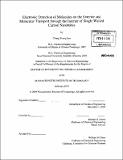Electronic detection of molecules on the exterior and molecular transport through the interior of single walled carbon nanotubes
Author(s)
Lee, Chang Young
DownloadFull printable version (22.98Mb)
Other Contributors
Massachusetts Institute of Technology. Dept. of Chemical Engineering.
Advisor
Michael S. Strano.
Terms of use
Metadata
Show full item recordAbstract
Single walled carbon nanotubes (SWNT) are unique materials with high surface to volume ratio and all atoms residing on the surface. Due to their tubular shape both exterior and interior of the SWNT are available for interaction with other molecules. One-dimensional electronic structure of SWNT is readily disrupted even by a single molecular binding event. Hence, one of the promising SWNT applications has been sorption-based sensors utilizing the exterior. Conversely, the interior of SWNT can potentially be used as a frictionless molecular conduit due to graphitic surface where molecular corrugation is minimized by high density of atoms. However, only few experimental results on the interior exist due to difficulties in designing a reliable platform. For the first part of this work we aim to utilize the SWNT exterior for reversible detection of nerve agents. Vast majority of the SWNT sensors exhibit irreversible sensor responses. The irreversibility is a major cause of sensor failure and also limits long term operation of the sensor. We show for the first time 1) the irreversible-to-reversible transition via simple surface amine chemistry, 2) integration with a micro-fabricated gas chromatographic (GC) column for selectivity. The platform benefits from the reversible SWNT sensor as well as from the separation capability of the GC, an analytical standard for the detection of diverse classes of organic molecules. For the second part, we demonstrate first time experimental monitoring of individual ions translocating through the interior of the single walled carbon nanotube. (cont.) By analyzing pore-blocking events caused by ions, we report for the first time 1) high ionic mobility through the SWNT interior, 2-3 orders of magnitude higher than the bulk mobility, 2) proton conductivity of ~ 10³ S/cm through the SWNT interior, 4 orders of magnitude higher than the Nafion proton exchange membrane and the highest ever reported, 3) proton/alkali ion separation factor of ~ 6x10⁷, 4) evidence of stochastic resonance in SWNT ion channels.
Description
Thesis (Ph. D.)--Massachusetts Institute of Technology, Dept. of Chemical Engineering, 2010. Cataloged from PDF version of thesis. Includes bibliographical references (p. 111-120).
Date issued
2010Department
Massachusetts Institute of Technology. Department of Chemical EngineeringPublisher
Massachusetts Institute of Technology
Keywords
Chemical Engineering.